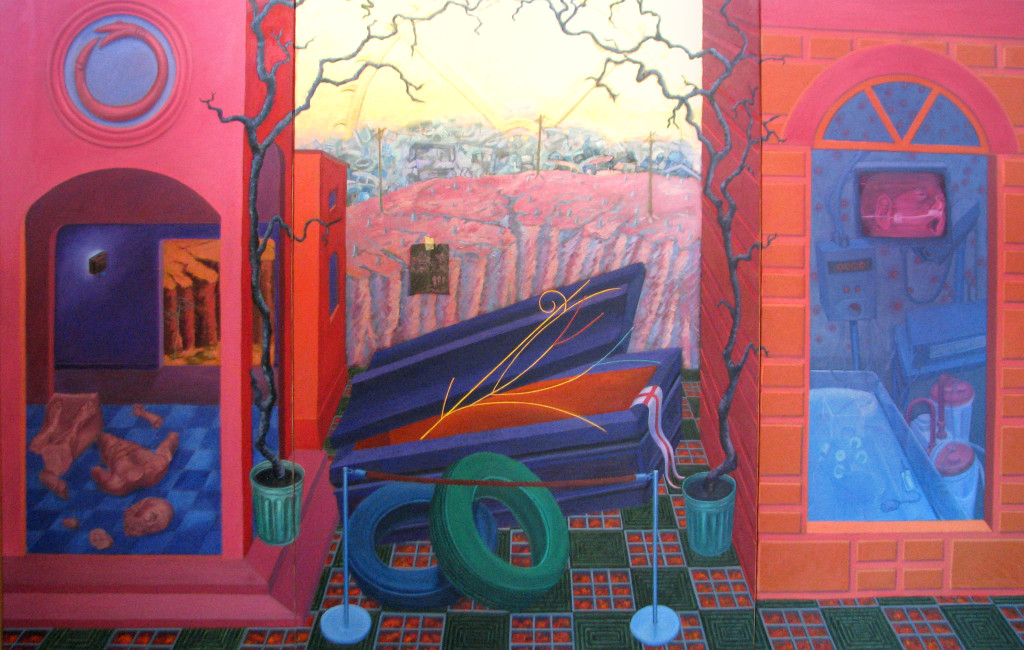Painted in 1989, Resurrection is the Culmination of the series that includes The Three Stages of man, Tabula Rasa, Exodus and Gate of Heaven. In a hinged triptych format, it is also the largest, most vibrantly colored, and most iconographically complex of this group. The central motif is a purple coffin, the lid ajar to reveal a glowing red interior from which emerges a bare but radiant branch. It actually reproduces a diagram of the tracks made in a bubble chamber by subatomic particles. A forked banner emblazoned with a red cross draped over one end of the coffin is a familiar symbol from Renaissance paintings of the Resurrection of Christ. The coffin is framed by a sort of crown of thorns comprising two leafless, twisting vines, which emerge from green trash cans on either side to rise and arch together above. Two tires lean against the coffin, which is separated from the viewer’s space by a rope stanchion. All of these objects rest on a tile floor, which is cut through to reveal a glowing red earth below, similar to that in Gate of Heaven. Beyond the coffin a landscape is visible, a delicate pink cliff side partially obscuring a massive pile of junked automobiles and ancient artifacts. On the clifftop are three tall, spindly crosses that suggest Golgotha but are connected by wires like telephone poles. Against the luminous gold and pink sky is silhouetted a gigantic spiked wheel like the one used to torture the early Christian Martyr St. Catherine. It is also the wheel of time and fortune, inexorably rotating.
Each wing of the triptych depicts a box-like room visible through an arched opening. On the left, an ancient symbol of the passage of time, a snake biting its own tail, occupies a blue circular field above the arch.Inside the room fragments of a marble statue lie scattered on a tile floor. |
It represents the artist himself, denied even the secondhand immortality afforded by a portrait in stone. The image was inspired by Renaissance paintings symbolizing the destruction of pagan religions by triumphant Christianity. Attached to the back wall of the room is a television set, a reminder that in the present century science has asserted its authority over that of religion.The television emits its blue light into empty space and has no audience. Its message will endure as long as its power source does, but is no more eternal than the systems of thought it momentarily supersedes.
The room on the right wing of the triptych portrays in shades of blue a scientific laboratory filled with mysterious containers, wire, and monitors. The pink face of an infant with a nose tube fills the screen of a wall-mounted monitor. The child suggests the eternal cycle of life through the birth of a new generation, but its life is artificially sustained, and the child itself is no where to be seen.
As in other paintings, a small black drawing is taped to the background of landscape in Resurrection. It portrays four spaceships and three figures with their hands raised to their heads. Perhaps they are observers, perhaps captives, but either way garnering a glimpse of existence beyond the limits of this earth. Mankind continually searches for meaning and immortality, whether through religion, art, science, or technology. In the modern world, science is expected to provide answers to the existential questions, but answers elude both those who probe the farthest reaches of the cosmos and those who search for increasingly infinitesimal components of the atom. It is Bireline’s contention that nothing will save us, neither religion nor science. Each system in turn simple enables people to organize their existence and impose meaning onto chaos. |
|


